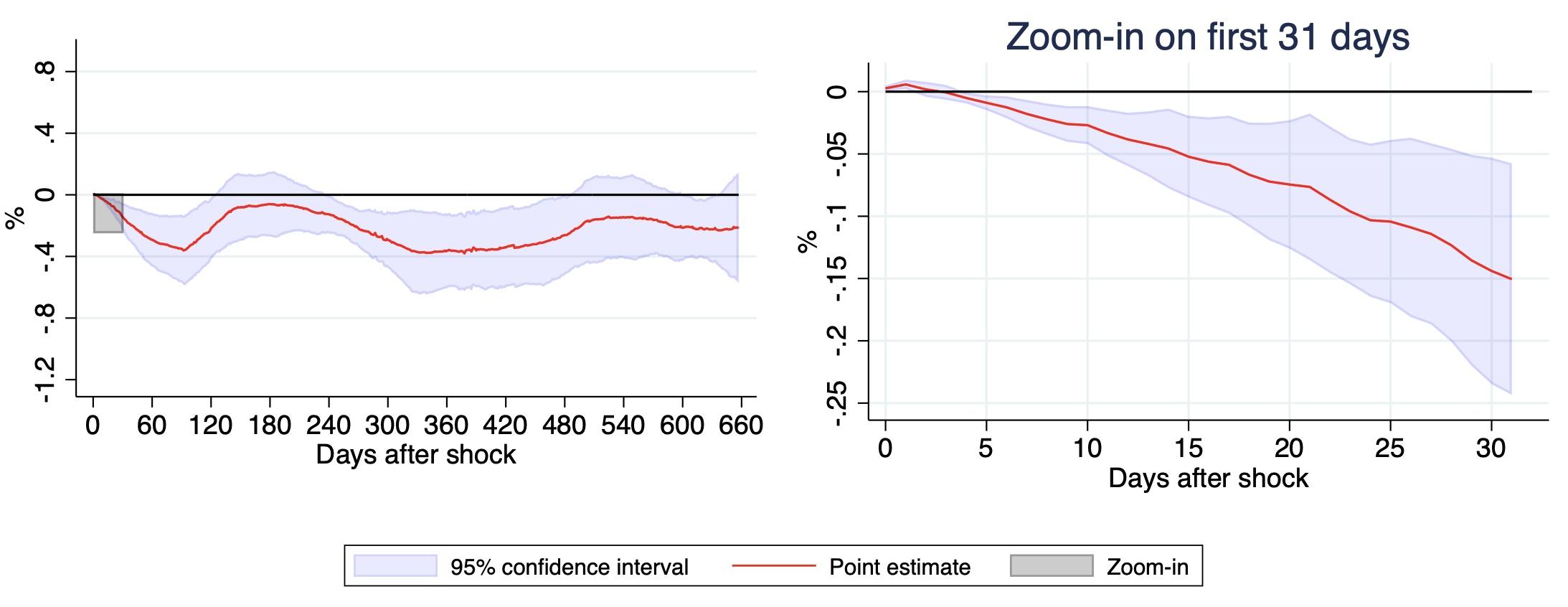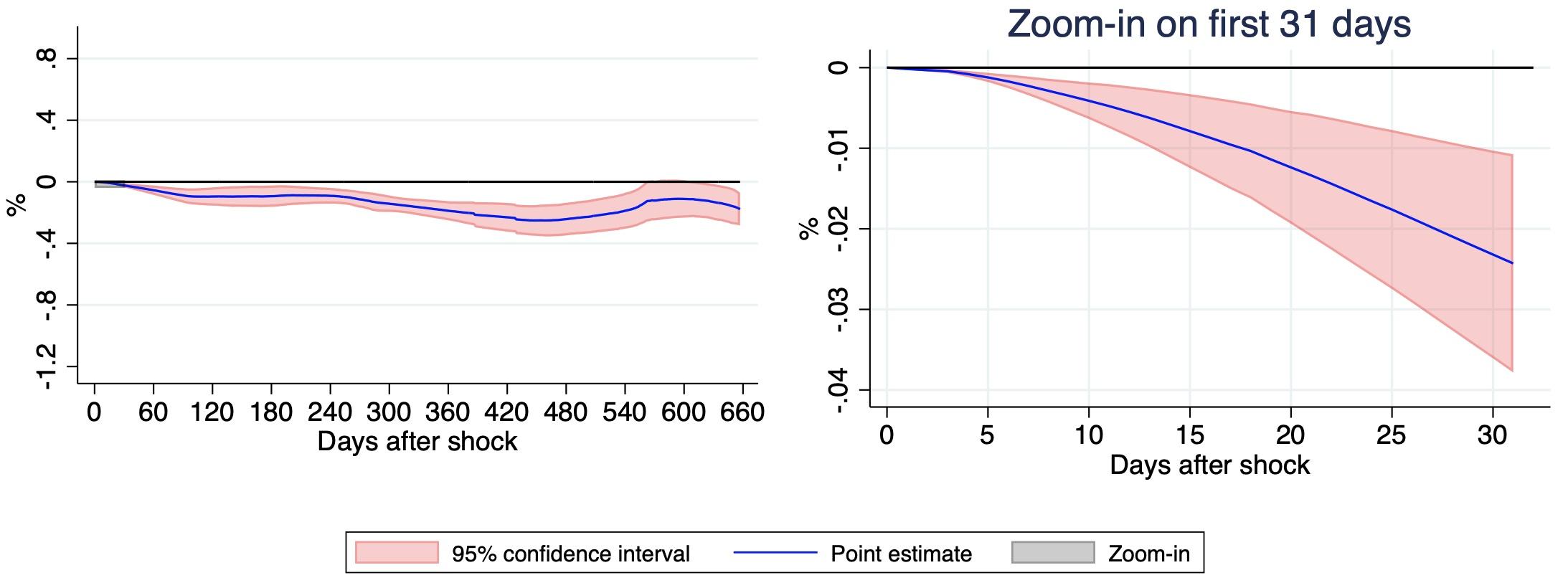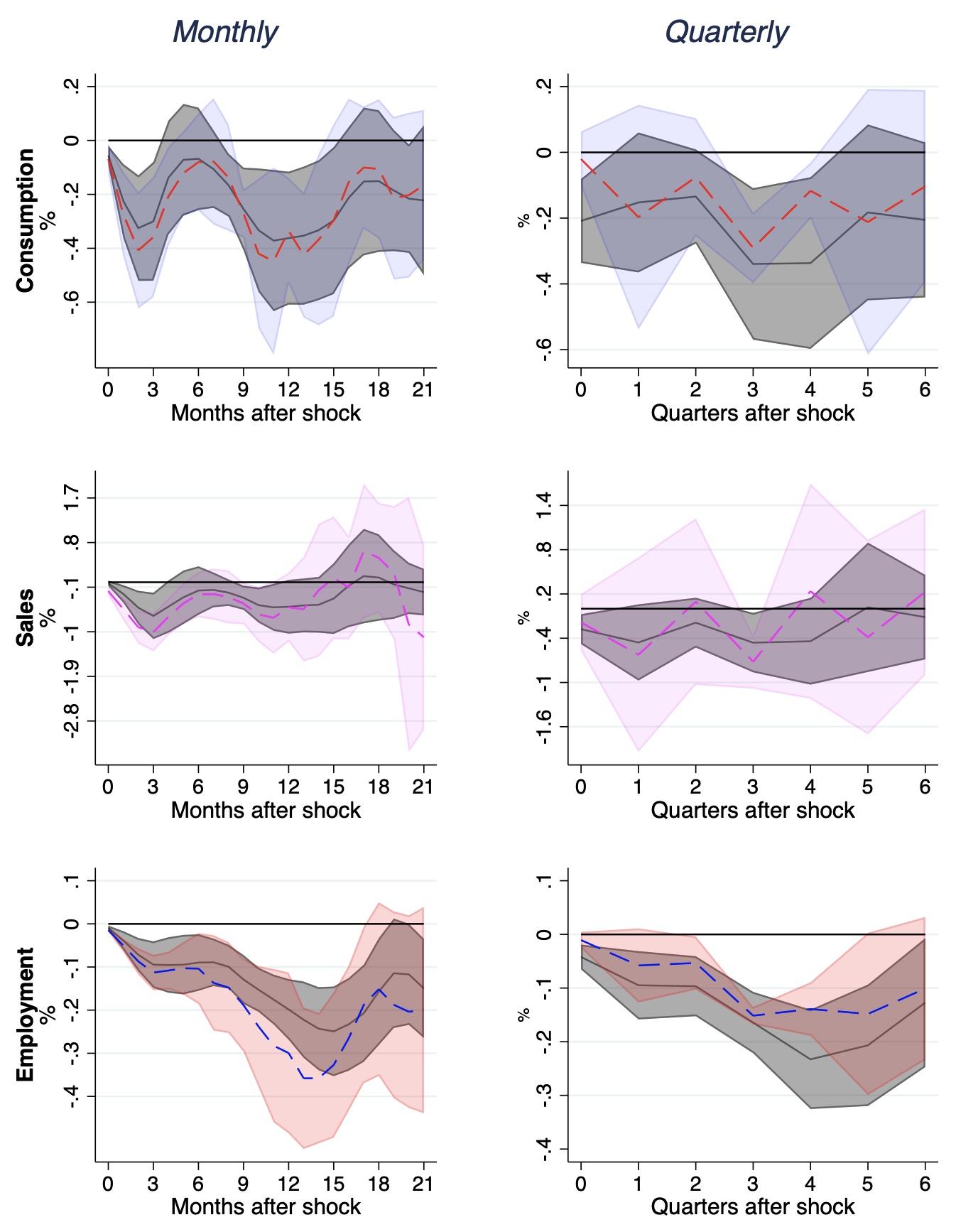Milton Friedman’s dictum concerning “long and variable lags” has been deeply influential among policymakers and academics alike. As recently as 1 February 2023, Fed Chairman Jerome Powell stated at a press conference that the Federal Open Market Committee is “…of course, taking into account ‘long and variable lags’ and that they are thinking about that”. Among academics, decades of research have shown that the transmission mechanism of monetary policy is complex and plays out over multiple channels that unfold at medium and long horizons. Missing in the debate is that monetary policy’s identified long lags do not rule out it also having short-run effects.
In a recent paper (Buda et al. 2023), we examine this issue by using three novel daily-frequency measures of economic activity for Spain:
- Daily consumption is built from the universe of consumption-related bank transactions recorded in the Spanish retail accounts of Banco Bilbao Vizcaya Argentaria (BBVA). This encompasses card transactions, cash withdrawals, regular direct debits, and occasional transfers.
- Daily corporate sales are constructed from daily Value Added Tax (VAT) declarations by firms and made publicly available by the Spanish Tax Authority.
- Daily employment is derived from the total number of workers registered in the Spanish Social Security system on any given day and made publicly available by the Spanish Ministry for Inclusion, Social Security and Migration.
The consumption and employment series began on 1 April 1 2015, while the sales series began on 1 July 2017. All series run through 31 December 2021.
Our measure of monetary policy actions is the changes in one-year euro bond yields around ECB policy rate announcements, taken from Altavilla et al. (2019). These represent the monetary policy ‘shock’ that is exogenous to economic conditions. Our basic empirical strategy is then to regress day t + h outcomes on day t monetary shocks to trace out short and variable lags via impulse response functions (IRFs).
Short and variable lags of monetary policy transmission
In Figure 1, we show that the effects of monetary policy shocks can be detected already in a matter of days. Specifically, we find that total household consumption begins to decline five days after a contractionary monetary policy shock. Consumption then reaches a trough 93 days after the shock, with a contraction of 0.35%, followed by another trough 330 days later, with a contraction of 0.4%. This finding is complementary to that of Grigoli (2023), who documents a rapid response to monetary shocks of credit card spending, a subcomponent of total consumption. Corporate sales, which include not only sales of consumption goods but also of investment and intermediate goods, react more slowly than consumption but follow a similar pattern. Their response is only statistically significant after 30 days. Sales then recover about six months from the shock but fall again in the fourth quarter. Finally, while a response of aggregate employment is statistically detectable early on relative to consumption and sales, the response is initially negligible in magnitude, and its decline is smoother and steadier. Employment reaches its trough 459 days after the shock, with a fall of 0.25%.
Figure 1 Daily response of economic activity variables to a monetary policy shock
a) Consumption
b) Firms' sales
c) Employment
Notes: These figures show impulse responses of daily series for consumption, corporate sales, and employment in reaction to a one standard deviation increase in a monetary policy shock. The responses are reported in levels. The 95% confidence intervals are computed from heteroskedasticity-robust standard errors. The left column traces out the effect over 660 days, while the right column zooms in on the first 31 days.
In addition, we also explore our rich consumption and sales data to show that monetary policy shocks affect more durable and luxury goods (e.g. transport, restaurants and hotels) than essential goods (e.g. food, communication and health) and that more downstream sectors (e.g. wholesale and retail trade) react more quickly to monetary policy shocks than more upstream sectors (e.g. energy and construction).
In summary, our results both support Friedman’s view and qualify it. The long-run responses of consumption, sales, and employment we observe corroborate the idea that the effects of monetary policy fully unravel at relatively long horizons. On the other hand, we also observe that monetary policy shocks are transmitted to the economy over very short lags that are variable in economically meaningful ways, with consumption, sales, and employment displaying notably different dynamics.
Time aggregation hinders the detection of the short-run effect of policy
Most economic activity series are available only at monthly and quarterly frequencies. How would the results from the empirical model differ if we could only access our data at these coarser intervals? To address this issue, we compare monthly and quarterly averages of our daily IRF regression coefficients (i.e. average values of the curves in Figure 1) with IRFs estimated using monthly and quarterly series, respectively, derived from our daily series.
In Figure 2, we show the IRFs of aggregated (averaged) daily responses from our baseline, together with the IRFs obtained using lower frequency data for consumption sales and employment. Results differ sharply at monthly versus quarterly frequency. Working with data on a monthly frequency does not appear to make a significant difference in detecting short-run effects. Using quarterly data, however, we find no significant same-quarter responses of consumption, sales or employment to monetary policy shocks, while we do so when using averaged daily responses. Quarterly aggregation shifts information in the data to lower frequencies: the first statistically significant response across all variables is detected only in the third quarter after the shock. Figure 2 also highlights differences in the responses' persistence: with time aggregation, the long lags seem less persistent—at longer horizons, the number of statistically significant lags is lower. In sum, we find that time aggregation may confound the lags in the transmission of monetary policy, shifting information in the data to lower frequencies. This finding suggests that the frequency of the data most commonly available in macro-econometric work may have misleadingly supported some of the "only after long and variable delays" conclusions.
This is a consequential empirical result for both theory and policy, stressing the need for further investigation into the root causes of this discrepancy. The problem may be relevant to several other variables. Complementing our results, Jacobson, Matthes and Walker (2022) find that, in contrast to previous findings using lower-frequency data, the perverse response of daily inflation to high-frequency monetary policy shocks is short-lived, if present at all.
Figure 2 Monthly and quarterly response of consumption, sales and employment to a monetary policy shock
Notes: The monetary policy shock in this exercise is normalized to one standard deviation of monetary policy shocks at a daily frequency so that its size is the same for the monthly and quarterly IRFs. The responses are in per cent deviation from the unconditional mean (in level). The 95% confidence intervals are computed from heteroskedasticity-robust standard errors. The left column shows the IRFs for the monthly frequency and the right column shows the IRFs for the quarterly. Dashed lines are the low-frequency data (monthly and quarterly) IRFs point estimates, while solid lines are the daily IRFs averages at the same monthly and quarterly frequencies.
Conclusion
The increasing availability of data on economic activity at high frequencies brings important benefits to research and policymaking. One of them is to create new opportunities to study how monetary shocks affect economic dynamics at very different and highly dispersed time frames. In our study, we have taken one step in this direction by aligning daily consumption, sales, and employment data from Spain with monetary policy announcements which also occur on specific days.
New research reproducing and expanding our analysis over longer samples and across countries may reveal that the economic transmission of monetary policy is heterogeneous and that short-run responses are not universal. For example, they may be particularly prominent in Spain because of the prevalence of variable-rate mortgages (see Corsetti, Duarte, and Mann 2022). Yet, it is important to keep in mind that very short lags are already seen in a number of recent studies documenting same-month responses using long samples (Jarocinski and Karadi 2020, and Miranda-Agrippino and Ricco 2021). Our study points to the potential benefits of ‘opening the box’ via the extensive use of information at high frequency. Overall, this line of research raises fundamental theoretical and empirical questions about the transmission of monetary shocks and emphasizes the need to investigate how these shocks affect different demand components over different time horizons and how demand ultimately drives overall economic activity.
References
Altavilla, C, L Brugnolini, R S Gürkaynak, R Motto, and G Ragusa (2019), “Measuring euro area monetary policy”, Journal of Monetary Economics 108: 162–179.
Buda, G, V M Carvalho, G Corsetti, J B Duarte, S Hansen, A S Moura, A Ortiz, T Rodrigo, J V R Mora, G A Silva (2023), “Short and variable lags”, Janeway Institute Working Paper No. 2308.
Buda, G, S Hansen, T Rodrigo, V M Carvalho, Á Ortiz, and J V R Mora (2022), “National Accounts in a World of Naturally Occurring Data: A Proof of Concept for Consumption”, CEPR Discussion Paper No. 17519.
Corsetti, G, J B Duarte, and S Mann (2022), "One money, many markets", Journal of the European Economic Association 20(1): 513–548.
Friedman, M (1961), "The lag in effect of monetary policy", Journal of Political Economy 69(5): 447–466.
Jacobson, M, C Matthes, and T B Walker (2022), "Inflation measured every day keeps adverse responses away: temporal aggregation and monetary policy transmission", FEDS Working Paper No. 2022-54.
Jarocinski, M and P Karadi (2020), “Deconstructing monetary policy surprises: the role of information shocks”, American Economic Journal: Macroeconomics 12(2): 1–43.
Miranda-Agrippino, S and G Ricco (2021), “The transmission of monetary policy shocks”, American Economic Journal: Macroeconomics 13(3): 74–107.
Sandri, D and F Grigoli (2023), “The analysis of credit card data can shed new light on the effects of monetary policy”, VoxEU.org, 13 April.
















